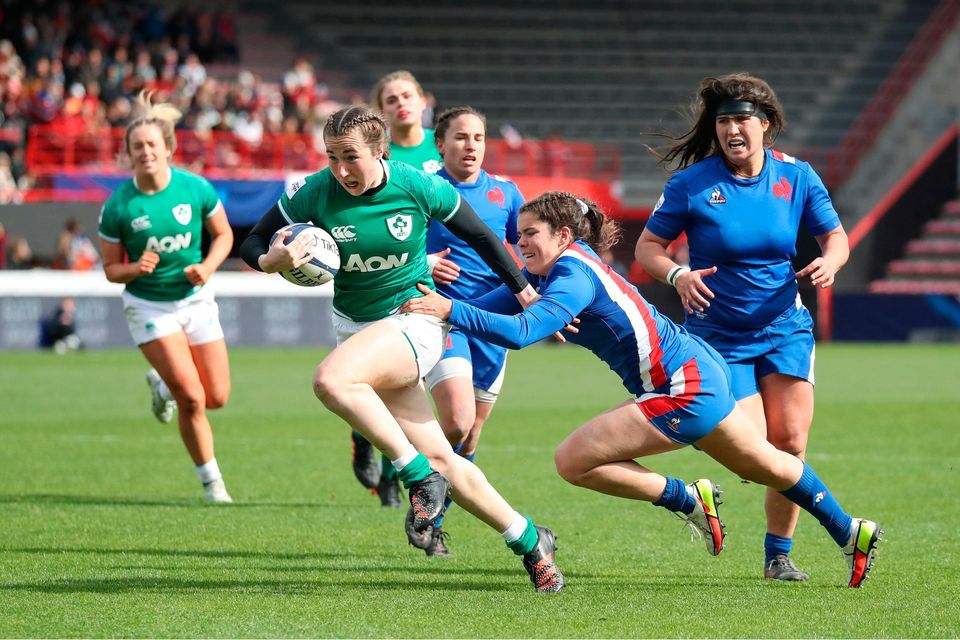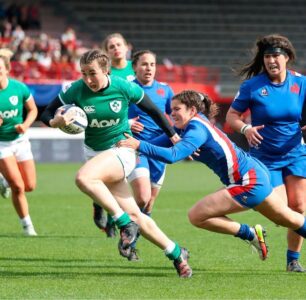Attacking in rugby is crucial for gaining territory and scoring points. It involves strategic ball movement, support play, and exploiting gaps in the opponent’s defense to create scoring opportunities.
Discover the key strategies and techniques for effective attacking in women’s rugby, including ball movement, support play, and creating scoring opportunities.]
Attacking FAQ
- Attacking
- What does Chip and chase mean?
Chip and chase is a rugby tactic where a player kicks the ball forward, then quickly chases after it, aiming to regain possession or create an opportunity by putting pressure on the opposing team’s defense. It requires precise timing and skillful execution to effectively execute this maneuver.
- What does counter attack mean?
Counterattack in rugby refers to the offensive strategy employed by the defending team immediately after gaining possession of the ball. Instead of simply focusing on defense, the team seizes the opportunity to quickly transition into attack mode, aiming to catch the opposing team off guard while they are not fully organized defensively. It often involves rapid ball movement and exploiting gaps in the opposing team’s defensive line.
- What does Dummy pass mean?
A dummy pass in rugby is a deceptive move where a player pretends to pass the ball to a teammate but instead retains possession by holding onto the ball. It is used to deceive the opposing defenders, creating space or confusion in the defensive line, allowing the attacking team to gain an advantage and advance the ball further down the field. Successful execution of a dummy pass requires good timing and coordination with teammates.
- What is a pod in rugby?
In rugby, a pod refers to a small group of players from the same team who work together closely, typically during set piece plays or specific phases of the game. These players support each other both in attack and defense, forming a cohesive unit to maintain possession, create scoring opportunities, or disrupt the opposition’s play. Pods often consist of forwards or backs who collaborate strategically to achieve their team’s objectives on the field.
- What is a rugby attack?
A rugby attack is the offensive phase of play where the team in possession of the ball attempts to advance towards the opponent’s try line to score points. It involves various tactics, strategies, and coordinated movements by players to break through the opposition’s defense, maintain possession, and create scoring opportunities. A successful rugby attack relies on teamwork, skillful ball handling, effective communication, and the ability to exploit weaknesses in the opposing team’s defense.
- What is a set piece play in rugby attack?
A set piece play in rugby attack refers to planned moves or formations executed by a team during set plays such as scrums, lineouts, or restarts (e.g., kick-offs). These plays are rehearsed in training and often involve coordinated movements and strategic positioning of players to gain an advantage over the opposition. Set piece plays aim to secure possession, create attacking opportunities, or set up scoring chances by exploiting weaknesses in the opposing team’s defense.
- What is the "up and under" kicking strategy used in rugby?
The “up and under” kicking strategy in rugby involves a high, lofted kick aimed at gaining territory or putting pressure on the opposing team’s defense. It is typically used when a team is under pressure in their own half or to create contestable situations where players from both teams compete for the ball in the air. The objective is to either regain possession of the ball or force the opposing team into making mistakes, such as knocking the ball on or conceding possession.
- What is the difference between a forward and a back's role in a rugby attack?
In rugby, forwards and backs have distinct roles in attack. Forwards, typically larger and more physical players, are responsible for winning possession of the ball, gaining ground through powerful runs and strategic positioning in set piece plays, and providing support to teammates by securing possession in rucks and mauls. Backs, on the other hand, are typically faster and more agile players who focus on exploiting space, creating scoring opportunities, and executing tactical moves to penetrate the opposition’s defense and score tries.
- What is the importance of alignment and spacing in a rugby attack?
Alignment and spacing are crucial aspects of a successful rugby attack as they dictate the effectiveness of ball movement, player support, and offensive strategy. Proper alignment ensures that players are positioned strategically across the field to maintain continuity of play, create passing options, and exploit gaps in the opposition’s defense. Spacing, on the other hand, refers to the distance between players, which should be optimized to maximize passing lanes, create overlaps, and prevent the defense from easily shutting down attacking opportunities. Effective alignment and spacing facilitate fluid ball movement, coordination among teammates, and the ability to capitalize on scoring chances during a rugby match.
- What is the importance of communication in executing rugby strategies?
Communication plays a vital role in executing rugby strategies as it facilitates coordination, teamwork, and effective decision-making among players on the field. Clear and timely communication ensures that teammates are aware of their roles, responsibilities, and the unfolding dynamics of the game, allowing them to make informed decisions, adjust tactics, and respond to changes in the game situation promptly. Effective communication enables players to coordinate attacks, organize defensive structures, and exploit opportunities, ultimately contributing to the team’s success and performance on the field.
- What is the role of the fly-half in executing offensive strategies?
The fly-half, also known as the first five-eighth, is a key playmaker in rugby responsible for orchestrating the team’s attack and executing offensive strategies. Positioned between the forwards and backs, the fly-half often serves as the primary decision-maker, playmaker, and tactical initiator, directing the flow of play, distributing the ball to teammates, and exploiting defensive weaknesses to create scoring opportunities. The fly-half’s role involves decision-making under pressure, accurate passing, effective kicking, and the ability to read the game to capitalize on attacking chances and set up scoring opportunities for the team.
- What is the role of the fullback in a counter-attack situation?
In a counter-attack situation in rugby, the fullback plays a pivotal role in supporting the team’s transition from defense to attack. Positioned at the back of the defensive line, the fullback is often the last line of defense and serves as a key decision-maker when fielding kicks, securing possession, and initiating attacking plays. During counter-attacks, the fullback may join the attacking line, provide support to ball carriers, create overlaps, or exploit space to launch counter-attacking moves and capitalize on defensive gaps or mismatches to advance the ball into opposition territory. The fullback’s role combines defensive solidity with attacking flair, requiring strategic positioning, tactical awareness, and the ability to read the game to maximize scoring opportunities for the team.
- What is the role of the scrum-half in a rugby attack?
The scrum-half, also known as the half-back, is a crucial position in rugby attack responsible for distributing the ball from set piece plays and breakdowns, orchestrating attacking moves, and providing quick and accurate service to teammates. Positioned behind the forwards, the scrum-half acts as the link between the forwards and backs, facilitating ball movement, organizing attacking patterns, and exploiting defensive weaknesses to create scoring opportunities. The scrum-half’s role requires quick decision-making, sharp passing skills, vision, and the ability to read the game to effectively manage the tempo and flow of the team’s attack during a rugby match.
- What is the significance of the fly-half in a rugby attack?
The fly-half plays a pivotal role in rugby attack due to their strategic positioning, decision-making authority, and playmaking abilities on the field. As the primary orchestrator of the team’s attack, the fly-half directs the flow of play, dictates attacking strategies, and coordinates the movements of forwards and backs to create scoring opportunities and exploit defensive weaknesses. With their vision, passing accuracy, kicking prowess, and tactical acumen, the fly-half serves as the linchpin of the team’s offensive maneuvers, driving the attack forward, and orchestrating attacking moves to penetrate the opposition’s defense and score points. The fly-half’s ability to read the game, make split-second decisions, and execute skillful plays under pressure significantly influences the team’s performance and success in rugby matches.
- What's a drop goal?
A drop goal in rugby is a method of scoring points by drop-kicking the ball over the crossbar and between the goalposts during open play. It is typically attempted when a team is within kicking range of the opposition’s goalposts and under pressure from the defense. Unlike a conversion kick, which is taken after scoring a try, a drop goal can be attempted at any time during the game and is worth three points if successful. Successful execution of a drop goal requires precision timing, good technique, and composure under pressure to accurately strike the ball and score points for the team.
- What's a grubber kick in rugby?
A grubber kick in rugby is a low, bouncing kick along the ground aimed at gaining territory, evading defenders, or putting pressure on the opposing team. It is often used as a tactical kicking option to exploit space behind the defensive line, force defenders to retreat, or create scoring opportunities for teammates to chase and gather the ball. A well-executed grubber kick requires precise control of the ball’s trajectory, angle, and force to bounce favorably and evade opposing players, ultimately enhancing the attacking team’s field position and strategic advantage during the game.
- What's the role of footwork in evading defenders in rugby?
Footwork plays a crucial role in evading defenders in rugby by allowing ball carriers to maneuver quickly, change direction, and create space to outmaneuver opposing players. Agile footwork enables players to sidestep, jink, or swerve past defenders, maintaining balance and momentum while advancing towards the try line. Effective footwork involves rapid acceleration, deceleration, and dynamic movements to deceive defenders, exploit gaps in the defensive line, and create scoring opportunities for the attacking team. Mastering footwork techniques through practice and skill development enhances a player’s ability to evade tackles, break through defensive lines, and contribute to the team’s success in rugby matches.

